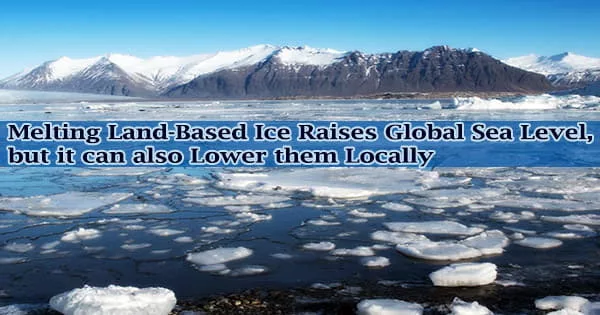Sea levels are rising as a result of two processes: thermal expansion, which occurs when water expands due to increased warmth, and melting of land-based ice, which occurs when meltwater flows into the ocean.
The subtle phenomena of gravitational pull is less well-known in relation to the latter. When a big ice sheet melts, the global mean sea level rises, but the local sea level around the ice sheet may actually fall.
A researcher from Saint Joseph’s University illustrates this effect through a series of calculations in the American Journal of Physics, published by AIP Publishing, starting with a simple, analytically tractable model and progressing to more sophisticated mathematical estimations of ice distributions and gravitation of displaced seawater mass.
The study presents numerical calculations for sea-level change caused by a 1,000-gigatonne ice loss, using parameter values adequate for the Greenland and Antarctic ice sheets.
My contribution here is to go in the opposite direction, making a model that is so drastically simplified that it can be used as an example in undergraduate courses. The gravitational pull phenomenon is a fascinating consequence of basic physics, and a great example of just how complex the earth system is and how well geophysicists can make sense of that complexity.
Douglas Kurtze
“If the meltwater comes from Greenland, then sea level far from Greenland rises by more than average, but sea level at the Greenland shore actually drops,” said author Douglas Kurtze. “This is at least partially because of how the loss of that ice changes the gravitational pull of the ice sheet.”
A huge ice sheet attracts seawater, causing a rise in sea level around the land it lies on. The global-mean sea level increases as ice melts into the ocean.
However, removing ice mass lowers the sheet’s gravity, decreasing the mound. The lowering of the mound height may be larger than the rise in global mean sea level in some circumstances, creating a dip in local sea level near the ice sheet.
While this cause of nonuniformity in sea-level change was recognized and systematically investigated as early as the 1880s, modern scientists developed sophisticated, detailed models that included other important considerations like changes in the earth’s rotation and alterations in the shape of the solid earth when mass, such as water and ice, is rearranged on the surface.
“My contribution here is to go in the opposite direction, making a model that is so drastically simplified that it can be used as an example in undergraduate courses,” said Kurtze.
“The gravitational pull phenomenon is a fascinating consequence of basic physics, and a great example of just how complex the earth system is and how well geophysicists can make sense of that complexity.”
After hearing a radio discussion with Jerry Mitrovica, a Harvard professor of geophysics and an expert in glacial isostatic adjustment, Kurtze was inspired to construct his model.





